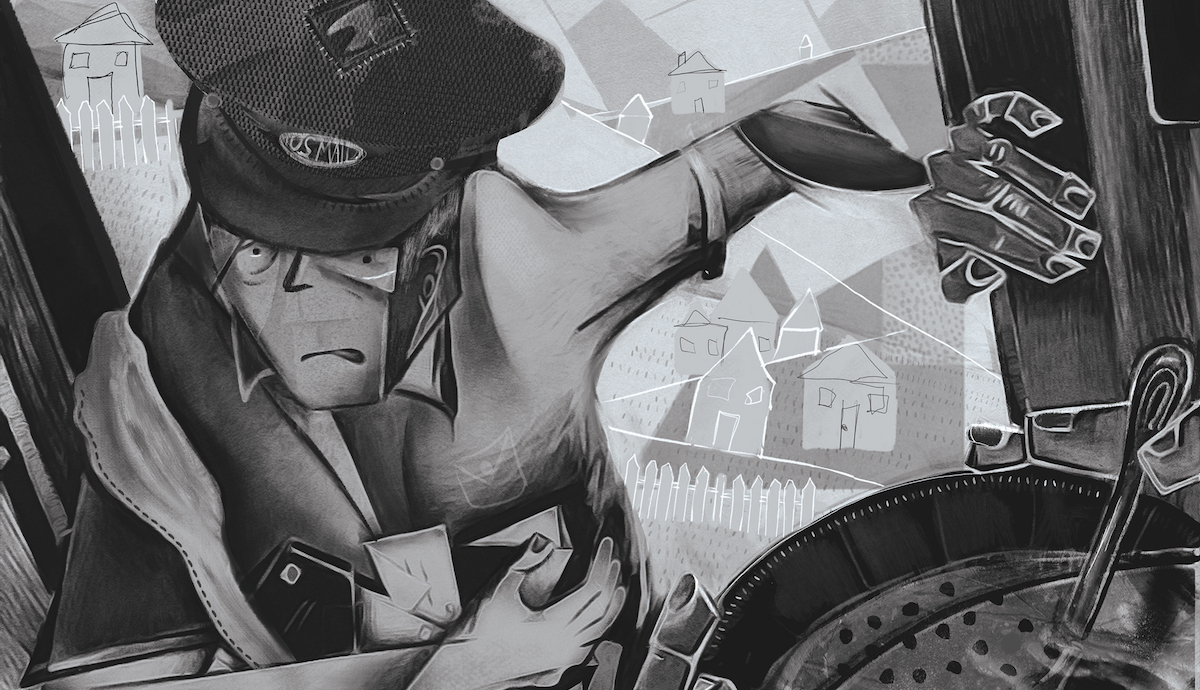On "A Murder During the Reagan Era"
"A Murder During the Reagan Era" appeared in NAR issue 302.3.
Dedicated to Roberta Barrett (1936-2016), who didn’t shirk from her morbid son-in-law’s curiosity and showed him the letter from her cousin in jail for murder and spawned this story.
This story rose from offal I had trimmed from a novel manuscript. As much as I enjoyed the tale of Yellow Birch being graced with its own post office, only to spark the paranoid jealousies of the postman’s wife, it proved more historical prelude to establish (perhaps more to me than anyone) the villagefolk’s propensity to buck up and work together through hardship. In the novel, this quality becomes key to how Yellow Birch deals with their zombie problem.
Yes, zombies. The working title of this novel: Friends and Neighbors - The Zombie Infestation of Yellow Birch, NY.
No, the mailman does not rise from the grave and take revenge on his wife. A couple of decades after the events of this story, at the beginning of the novel proper, black ops release a zombie virus from their underground lair, a former Cold War missile station (because government). But the people of Yellow Birch can’t bring themselves to kill their undead, these friends and neighbors who shared their pantries and pickups when others were out of work or had blown a transmission. This sense of community goes so far that, when a team of zombie hunters show up to clear Yellow Birch’s streets, the villagefolk gang up against them to protect their own.
This kind of topsy-turvy logic, of taking a germ of virtue (loyalty to your friends and neighbors) into a questionable execution (slaughtering those who have come to rid you of your zombie epidemic), is innately human and one of the key qualities of Anton Chekhov’s maxim of “truthful descriptions of persons.” When looking for more modern examples of this kind of cognitive dissonance, I am fond of luminaries Flannery O’Connor, James Baldwin and Samuel Beckett, but also I am often drawn to horror movies when hungry for storylines that excite and engage me as commentaries of the human condition (though The Misfit, from Flan-O’s “A Good Man Is Hard to Find,” is arguably the scariest character ever to hit the page).
A common image of horror is that of the scream queen floundering helplessly as she attempts to outrun the plodding maniacal killer...but if that’s your general impression of horror, realize you are hung up on an image from the seventies, man! Yes, sometimes even contemporary offerings resort to those old boilerplates, but such movies are ATM-style productions, passed through a studio in a quick grab for cash. In fact, modern horror has done more to depress the male bias in the movie industry than any other popular movie form. Good horror movies challenge us to face up to the dark places we can go (and have gone) as a species.
But in the midst of exposing the darker elements of humanity, horror also reveals the counterintuitive places where our strengths lie. Take The Exorcist or Jaws: when our baby girl is possessed by a demon named Pazuzu, or denizens of our sleepy summer town are getting masticated by a creature from the very ocean we make our living from, it isn’t the wizened old priest or salty sharkhunter who can save us (in fact, their deaths show us that experience makes us less prepared for such extremities). Chief Brody fears the ocean, and Father Karras is a wounded priest distrustful of his faith. Fearing our monsters proves to be our strongest weapon.
When Jordan Peele, half of the comedy duo Key & Peele and who does an Obama maybe even better than the genuine article, announced he wanted to do a horror movie, many took this as another joke. But the subsequent product, Get Out, is amazing social commentary. Peele himself has talked about the movie as an allegory of the disproportionate incarceration of black men in this country, but the movie also offers an exquisite trope that gets to the roots of racism. (SPOILER ALERT—feel free to skip to the next paragraph, if’n you haven’t seen this one yet.) The old, white followers of the Armitage brain transplant method see African-Americans as property, bodies they can take over and put themselves in, but at the same time they clearly envy these African-Americans, who are stronger and more capable (and in many ways better) than them--quite a profound statement on the that topsy-turvy logic of the human animal.
The Purge manifests class issues with a future US where the wealthy are granted carte-blanche once a year to slaughter the poor in the name of cleaning up crime. The Witch shows us the deep, unyielding patriarchy of religion and family, where the only escape for a young girl in colonial US might be witchcraft (or the accusation thereof). Certainly, the past year alone has showed us how far this country still needs to go before it can credit itself for just about any kind of equality. In horror, the storylines themselves may be often dismal and nihilistic, but the importance of human connection stands tall.
Take the recent hit It Follows, in which a young woman, Jay, becomes the target of an unstoppable creature bent on murdering her. She’s its target because she had sex with a man who was the creature’s previous target. Even if she passes the curse onto another sexual partner, the creature will once again target her if it kills the other. The overtones of venereal disease are of course quite obvious, and other critics have adeptly looked at the movie as a metaphor for the treatment of sexual assault survivors. Jay will never be able to destroy her nemesis and has to live with the knowledge that one day the creature will catch up with her. She has little to no control over the greater evils of the world. But she does have her sister and a true group of friends who support her, believe her and protect her as far as they are humanly able. Maybe it’s not the happy ending suitable for a rom-com world, but it feels more honest.
Recommended
Nor’easter
Post-Op Appointment With My Father
Cedar Valley Youth Poet Laureate | Fall 2024 Workshop






